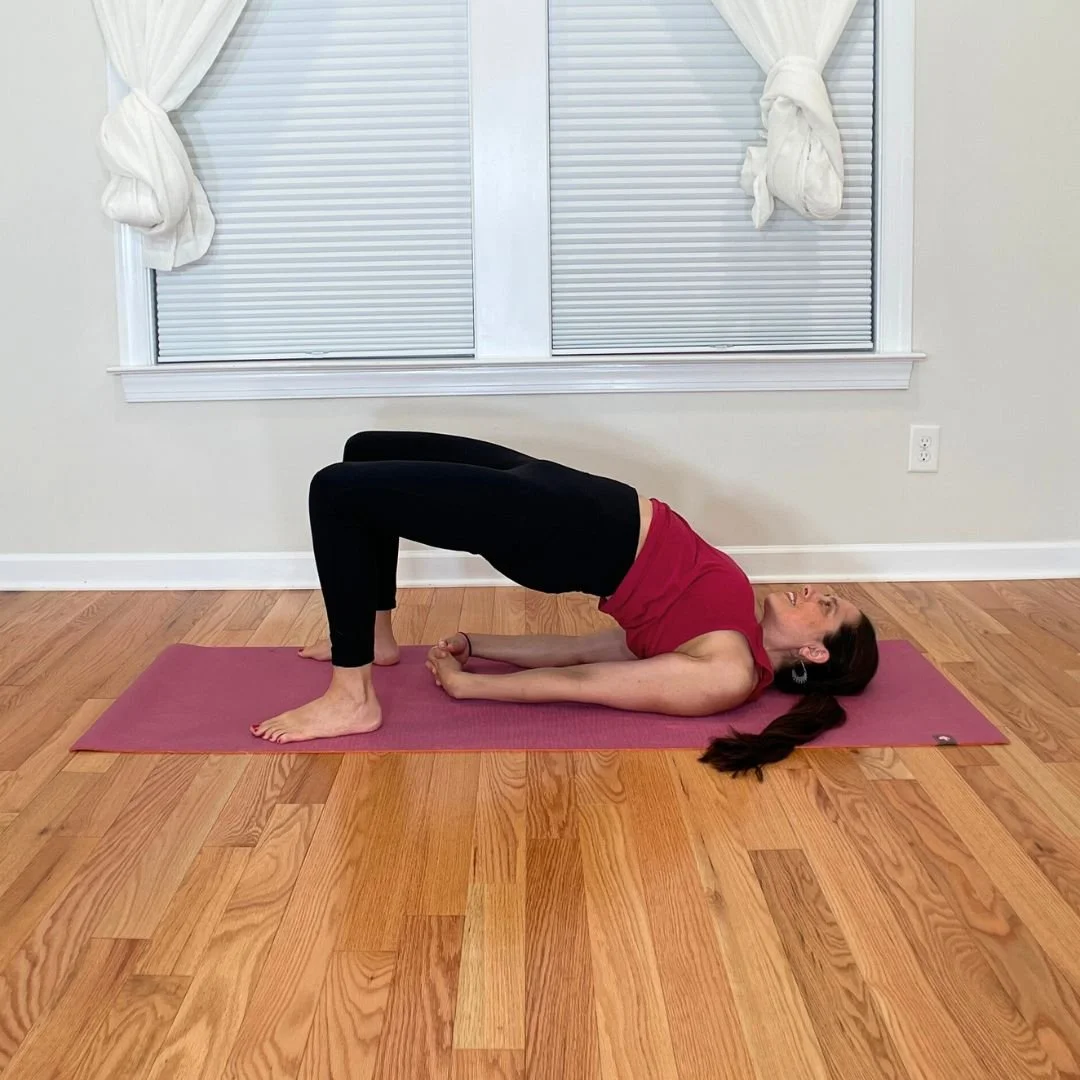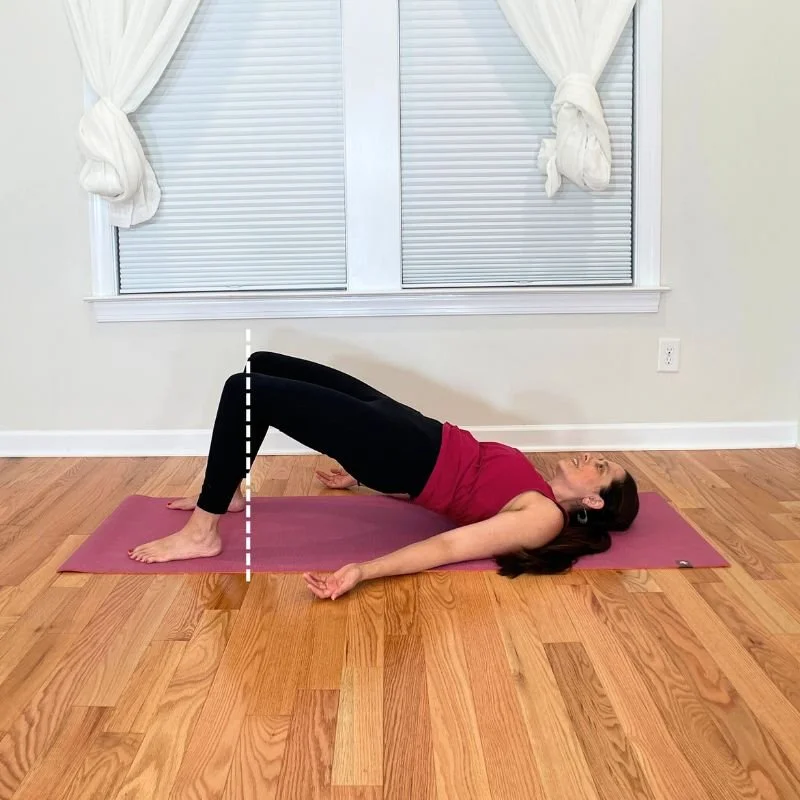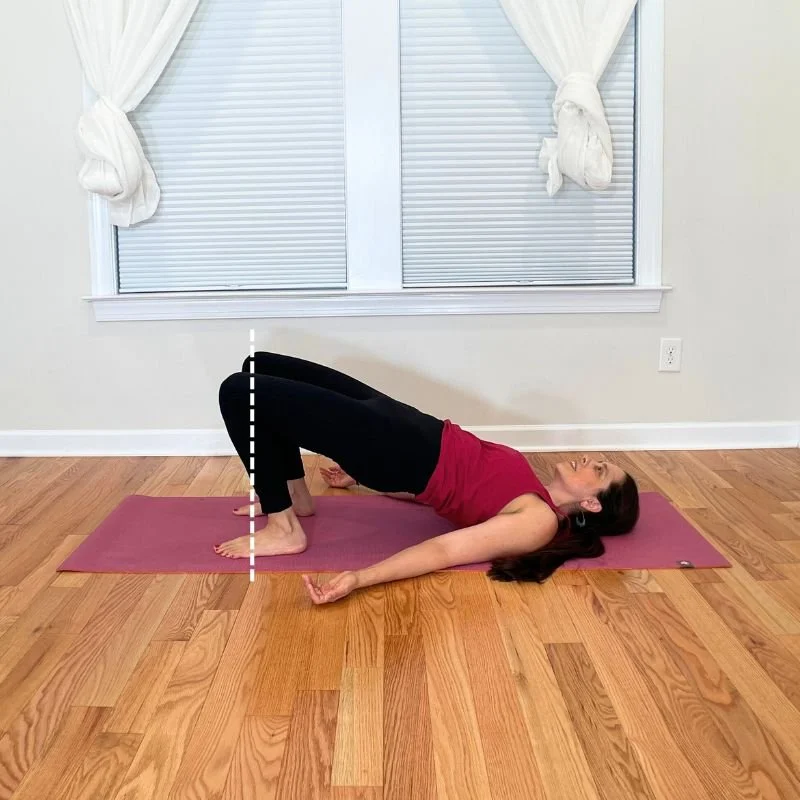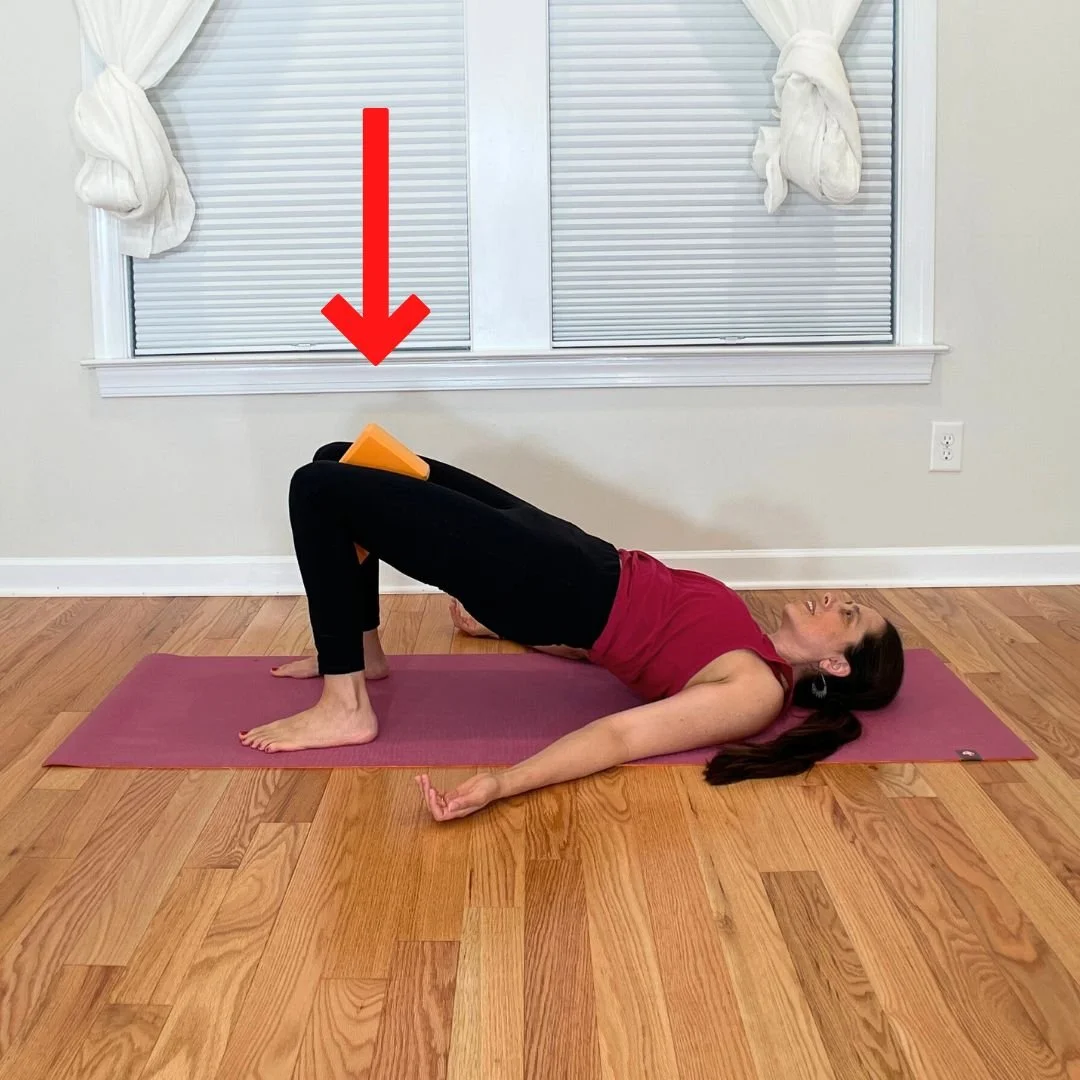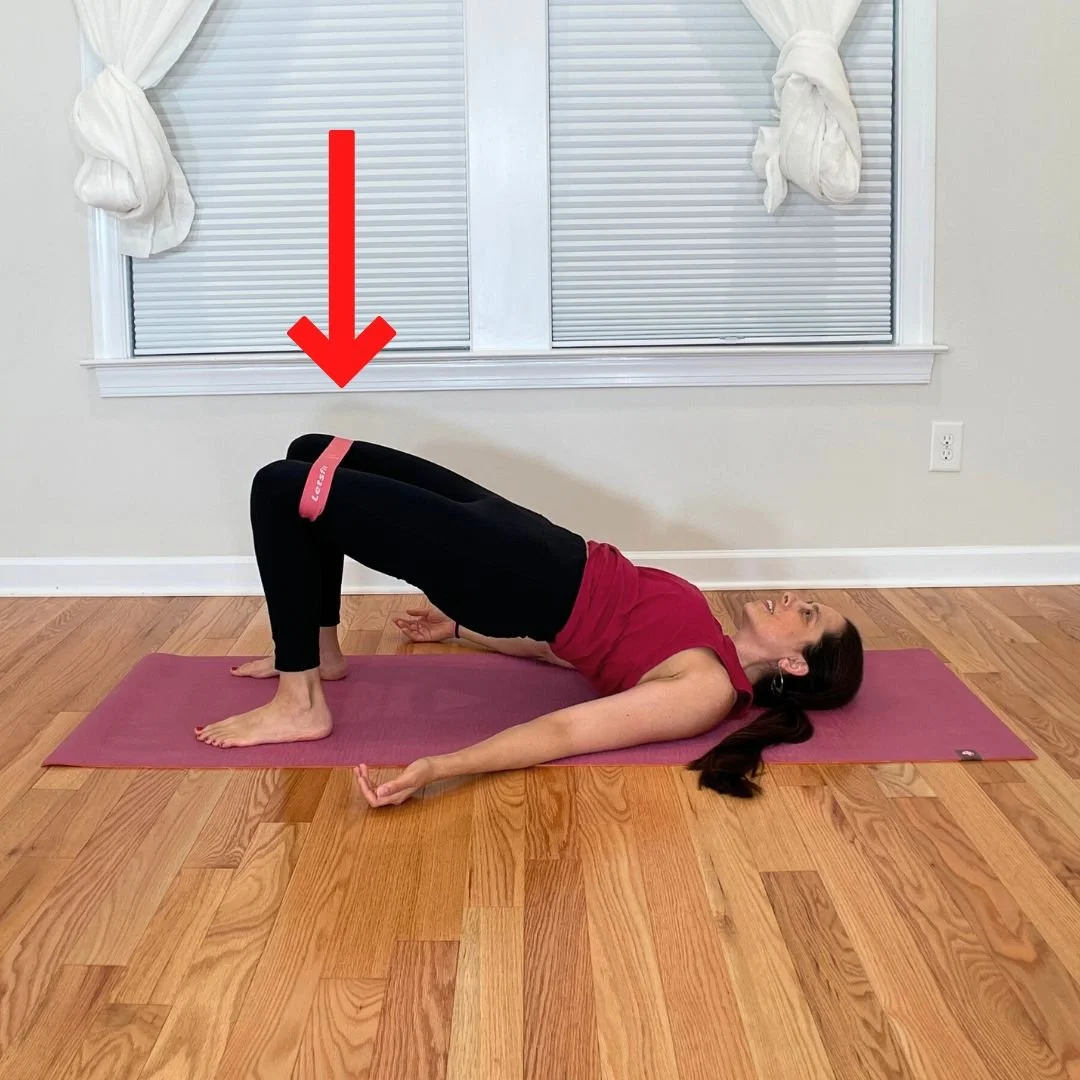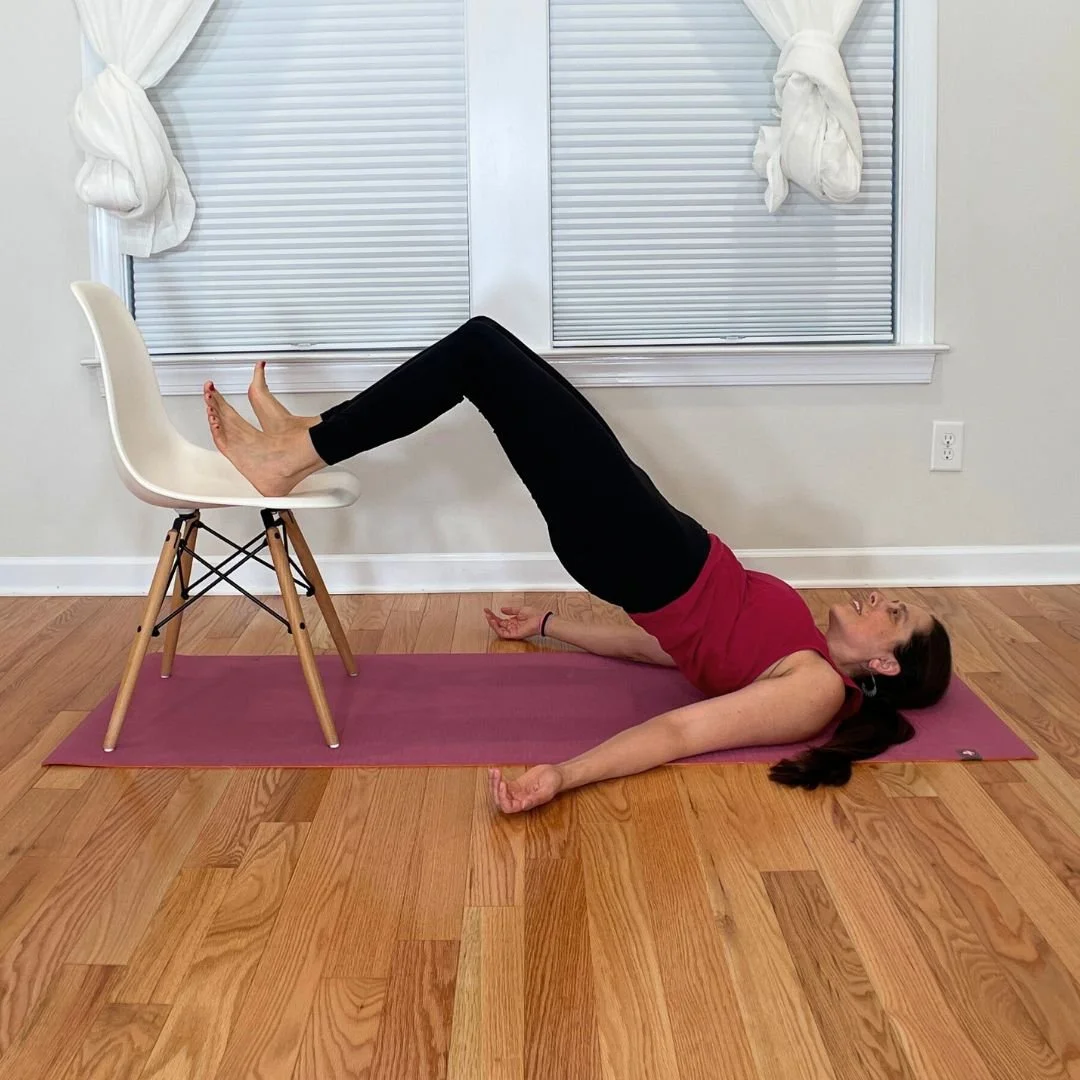Bridge Pose Variations: 6 Ways to Target Different Muscles (Backed by Science)
This blog post was first sent to Jenni’s email list as an email newsletter. Sign up for the JRY email newsletter here!
Ready for deep dive into bridge pose? Take your understanding of the biomechanics of this yoga pose to a new level!
I came across a new study (Colonna et al., 2025) all about the biomechanical nuances of bridge pose, and I thought our yoga geeky community might appreciate some of these insights! 🤓
We all know bridge pose (setu bandhasana), right? We lie on our backs, knees bent, feet flat, and lift our hips up off the floor. It’s a common pose we see in yoga, and it’s a great movement for targeting our posterior chain in general:
Classic yoga bridge pose
But this new narrative review highlights how small variations in alignment and/or prop usage can significantly change the way our muscles are activated in the pose.
Here are a few key takeaways from this study!
Knee Angle Changes the Muscle Activation Emphasis
Bridge pose can be performed in a variety of knee angles. For example, in yoga, we tend to perform bridge pose with the heels right under the knees (like in the photo above! ⬆️), which results in a vertical shin and a knee flexion angle of a little less than 90°.
But in the rehab world, bridge pose is often practiced with the feet slightly forward of the knees, which results in a shin that angles forward a bit and a knee flexion angle around 90°.
A rehab-style bridge looks more like this:
Rehab-style bridge exercise
We can also align bridge pose with the feet scooted in quite close to the hips. This moves the knees into more flexion and angles the shins back (rather than vertical or forward).
Feet-closer-to-hips bridge pose looks like this:
Bridge with the feet closer to the hips
And we can also practice bridge pose with the feet really far forward of the knees. This would be considered a long bridge pose and involves less knee flexion.
A “long bridge” looks like this:
Long bridge
So how do all of these knee angle options influence the biomechanics of bridge pose?
It turns out that the closer the feet are to the hips (a higher degree of knee flexion), the more the glutes and adductor magnus works and the less the hamstrings work.
And the further forward the feet are away from the hips – moving toward a long bridge – the more the hamstrings work and the less the glutes and adductor magnus work!
So if the goal is to target the glutes and/or adductor magnus, it’s better place the feet closer to the hips (more knee flexion). And if the goal is to target the hamstrings, it’s better to place the feet more forward (less knee flexion).
Why Does Knee Angle Change Muscle Recruitment?
When our feet are farther forward from our hips, our knees are less flexed (bent), and gravity creates a torque that tries to straighten them even more. This is called a knee extension torque.
In order to counter that knee extension torque, our hamstrings – which cross the back of our knees and perform knee flexion – work to actively flex the knees against gravity.
But on the flip side, when our feet are closer to our hips, gravity is actually trying to bend our knees even further – this is called a knee flexion torque. In order to lift up into bridge pose, our quads on the front of our thighs – not our hamstrings on the back of our thighs – work to extend the knees against gravity.
And here’s where the glutes and adductor magnus come in:
In the closer-footed version of bridge pose, because the knee flexion demand is reduced, the movement becomes more about hip extension – and that’s where the glute max and adductor magnus take the lead. These muscles work to lift the pelvis by extending the hips, especially when the hamstrings aren't being called on as much.
Ankle Position Affects Muscle Activation (but plays less of a role than knee flexion)
You might have seen a variation of bridge pose in which we dorsiflex our ankles – we lift the balls of the feet and and come onto our heels:
Bridge pose w/ dorsiflexion
How does this ankle variation affect muscle activation in bridge pose?
It turns out that despite popular thought, dorsiflexing does not increase activation of the glutes. 🤯 Glute activation remains the same whether we dorsiflex or have our feet flat on the floor.
However, when we dorsiflex, this does increase activation of the quadriceps, adductors, and obliques. (Cool, huh?)
And guess what else dorsiflexing does, yoga geeks? It decreases activation of the hamstrings!
Therefore, when the goal is to maximize hamstring activation in bridge pose, a flat foot is recommended. And when the goal is to maximize quadriceps, adductors, and oblique activation, coming up onto the heels is recommended.
Why Would Ankle Position Change Muscle Activation?
This may have to do something called “excitation overflow” – a phenomenon in which contracting a muscle causes adjacent muscles to also contract (Escamilla et al., 2024).
Check this out: the muscle that dorsiflexes our ankle is our front-shin muscle, the tibialis anterior. Because of excitation overflow, activating this muscle encourages activation in the muscles adjacent to the tibialis anterior on the front of the leg – the quads!
Likewise, the muscles that plantarflex (point) the ankle are on the back of the shin – the gastrocnemius and the soleus. When the feet are flat in bridge pose (with ~90° or less knee flexion), the plantarflexors contract, and because of excitation overflow, this encourages the muscles up the posterior kinetic chain – the hamstrings – to also contract!
Important Caveat for Yogis: Ankle Position Doesn’t Really Affect Muscle Activation in a “Yoga Bridge” ☝️
We’ve seen that in bridge pose, flat feet tend to activate the hamstrings more than dorsiflexed feet (heels down, balls of the feet lifted).
But here’s the catch: this effect is more relevant in the rehab-style bridge setup – where the feet are positioned slightly forward of the knees – than it is in the yoga-style bridge, where the heels are typically stacked directly under the knees.
Why does this matter?
In the yoga version, with vertical shins, there’s no real knee extension torque. Gravity isn’t trying to pull the knees straighter – so the hamstrings aren’t recruited significantly in the first place, regardless of what the ankles are doing.
It’s only when the feet are placed farther forward – like in rehab-style bridges or intentionally “long” bridges – that the hamstrings are called into action to resist knee extension. And that’s when ankle position (flat foot vs. dorsiflexion) starts to meaningfully influence glute vs. hamstring muscle activation.
So for yogis practicing the classic setup, ankle position likely won’t make a big difference in hamstring involvement – because the hamstrings simply aren’t doing much in that shape to begin with!
Additional Cool Findings From the Study:
Squeezing a yoga block between the knees (adduction) increases transverse abdominis activation more than traditional bridging or bridging with resisted hip abduction (theraband around the knees):
Bridge pose with a yoga block between the knees
Single-leg bridge produces some of the highest glute activation of any rehab exercise (up to 51% glute max, 58% glute med) and requires greater trunk muscle activation to resist rotation and maintain stability:
Single-leg bridge pose
Bridge with hip abduction (mini-band around knees) significantly increases glute max activation while reducing anterior pelvic tilt by about 20%:
Bridge pose with a mini-band
Elevating feet on a bench (or chair) increases activation of multifidus and other core muscles compared to traditional bridge pose:
Bridge pose with the feet elevated
Unstable surfaces under the feet like BOSUs or Swiss balls doesn’t consistently increase target muscle activation – and sometimes even decreases it.
Posterior pelvic tilt during bridge increases glute max activity! 🍑
Big Picture Takeaway
Bridge pose is a lot more modifiable than it looks, right?? Foot placement, ankle position, knee angle, posterior pelvic tilt, and more can all change the experience of the pose – and which muscles it’s targeting the most.
Understanding these nuances can be helpful when we want to tailor bridge pose toward specific muscle activation goals.
But in the bigger picture, if your aim isn’t to isolate certain muscles and you’re more interested in building strength through a general movement pattern, then I’d suggest simply setting up in whatever way helps you feel strongest and most supported in the shape. 💪
What’s Your Experience Been Like?
Do you use bridge variations in your practice or teaching? Do you ever intentionally shift the setup to emphasize different muscle groups? What have you noticed?
Reference:
Colonna, Saverio, et al. "Supine bridge exercise: a narrative review of the literature (Part I)." Cureus 17.3 (2025).

